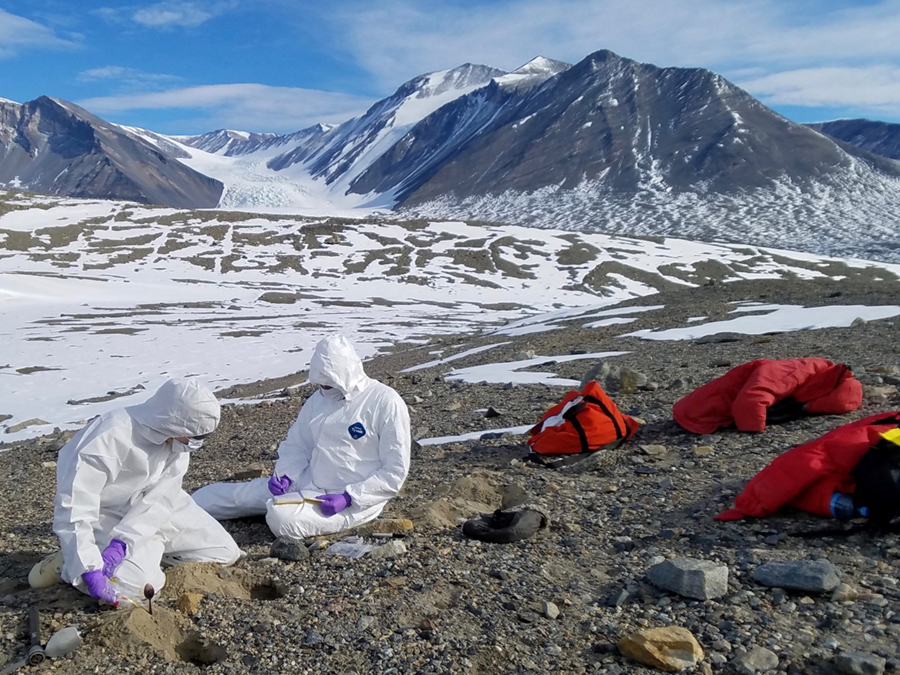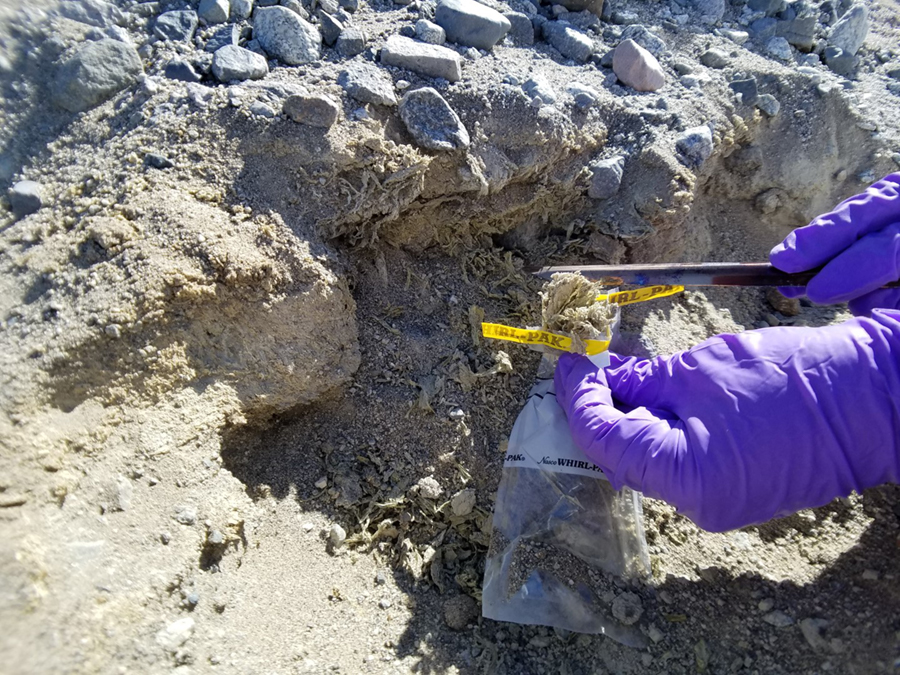The Edge of LifeScientists Hunt for Ancient MicrobesPosted September 19, 2017
Researchers working in Antarctica’s McMurdo Dry Valleys found evidence, in ancient dried microbial mats, of microorganisms that may have been alive for thousands of years. The discovery could have implications for biology in other parts of the world and even on other planets, such as Mars. Working during the past Southern Hemisphere summer, the research team collected samples and gene sequences from deposits of desiccated, prehistoric microbial colonies buried beneath the sandy surface, where lakes once were. They discovered unexpectedly long strands of DNA in creatures up to 15,000 years old, suggesting that these microorganisms have evolved mechanisms to preserve and actively repair their DNA over significant periods of time. More work needs to be done to confirm it, but these findings suggest that the microorganisms aren’t dead, but have been alive in a self-imposed protective state for millennia. The research may have global implications. Vast regions of the Earth’s surface, particularly Arctic tundras in in northern Canada and Siberia, have been starting to thaw for the first time in thousands of years. Embedded within them are microbes that have survived for millennia and could hold genetic secrets. The project is supported by the National Science Foundation (NSF), which manages the U.S. Antarctic Program. “Antarctica is the perfect place for testing theories of long-term cell survival,” said Sarah Stewart Johnson, an assistant professor at Georgetown University and principal investigator on the project. “In the Dry Valleys, we have the opportunity to study life when pushed to its very limit.” The Dry Valleys are a perpetually ice-free region of the southernmost continent, more than 98 percent of which is covered in a miles-thick sheet of ice. The valleys also are the site of one of NSF’s global network of Long Term Ecological Research site. The results also were aided by technological advances that didn’t exist just a few years ago. Initially the team had planned to only collect samples in the field, then do the final analysis at their home institutions, but recent advances in gene-sequencing technology has shrunk those devices to the point where the team could bring them out to the field in their pockets. One such device, the Oxford Nanopore MinION sequencer, is about the half the size of a pack of cards. “It’s amazing that you can take this technology into the field,” Johnson said. “This is the first time that’s it’s been possible to do DNA sequencing in situ here in the Dry Valleys.” In addition to their work with the MinION device, the team also set up the first ever full DNA sequencing core facility in McMurdo Station’s Albert P. Crary Science and Engineering center, the NSF-managed lab in Antarctica that is outfitted with a number of other, cutting-edge sequencing instruments and genetic equipment. Life is PersistentIn difficult conditions, some microorganisms enter a totally dormant state and wait until conditions improve. They dry out, causing their metabolic functions to slow and eventually shut down completely. Then when the surrounding environmental conditions improve, they rehydrate and resume normal metabolism. “Dormant spores are all over the place,” Johnson said. “They can hunker down and withstand a lot of environmental pressure. But then when conditions change and get better, they spring back to life.” 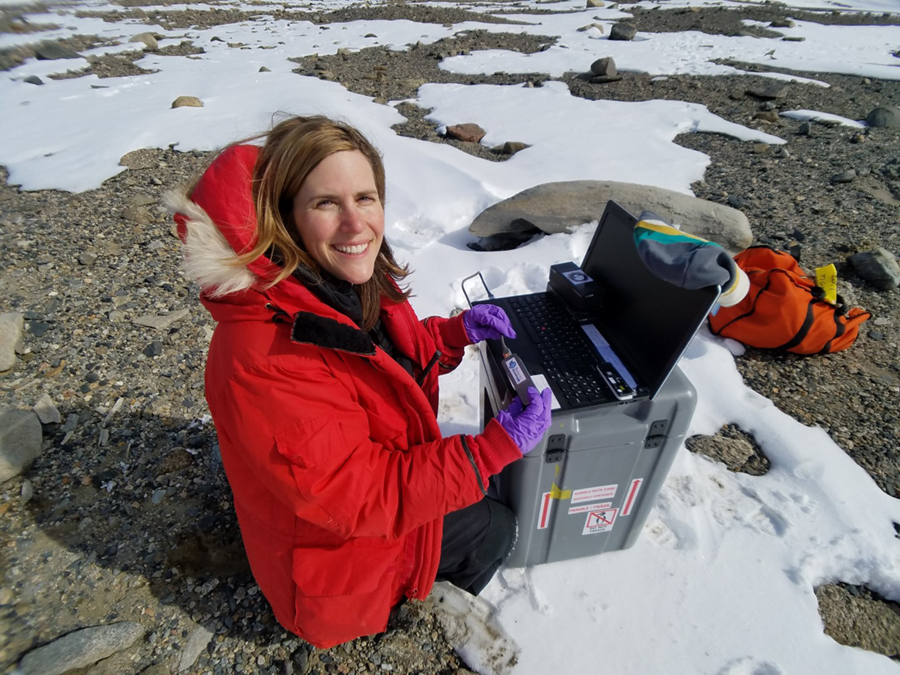
Photo Credit: David Goerlitz
Sarah Johnson uses the Oxford Nanopore genetic sequencer to decode the DNA they just collected, the first time DNA sequencing was done in the field in Antarctica
Even in this protected state, surviving dormancy for a long period of time is not easy, as damage will still set in if the cells aren’t continually repairing their genome. “The problem is that spores accumulate damage to their genomes while dormant,” Johnson said. “At a certain point, it becomes something they can’t bounce back from.” The damage accumulates in the cell’s DNA. Short for deoxyribonucleic acid, DNA is essential for all life to function. DNA is the genetic code that tells cells what they are and how to operate. Every DNA strand is made up of long strings of four types of molecules called nucleotides. Each nucleotide bonds with its specific partner, to create a complete base pair. These base pairs link together, forming a long chain resembling a ladder with nucleotide pairs as the rungs. Though the exterior of a dormant cell is hardened to resist harsh environmental conditions, the DNA inside is quite fragile. Being dormant goes a long way towards protecting the encased cell, but the DNA will still degrade over time by reacting with oxygen and water. The fact that bacterial cells can dry out and "go dormant" is not a new discovery; scientists have long understood that cells can shut down their metabolic activity and enter a dormant mode until their environment becomes viable for life again. However, new DNA sequencing technologies allow a deeper look into the genomes of these organisms, including the ability to pinpoint tiny chemical modifications associated with genome damage. In addition, these new approaches allow for sequencing longer DNA strands than have ever before been possible. 
Photo Credit: Scott Tighe
A researcher loads a collected algae sample into their genetic sequencer, a device small and durable enough to be used in the dry valleys.
“Because of the cold and dry conditions, Antarctica is full of short fragments of DNA from organisms that are no longer alive,” Johnson said. “Extremely long strands of DNA, orders of magnitude longer than those free-floating in the environment, can help us distinguish viable cells.” Scientists in the past have sequenced tiny strands of DNA from the remains of ancient organisms, but they’re not even close to being viable. “Once the cell dies, it breaks open, and all of that environmental damage comes and it shears up the DNA, it just can’t last that long,” said David Goerlitz, a genomics professor at Georgetown. “The longest it’s going to be is a few hundred base pairs.” Johnson and her team were able to find and sequence DNA that was tens of thousands of base pairs in length, many times longer than what would be recoverable if the molecules had been exposed to the environment. “It’s easy to get short fragments of DNA from things that aren’t alive,” Johnson said. “Anything over a few thousand base pairs, though, suggests something that just came out of an intact cell.” Finding these DNA strands does not conclusively prove that these cells are repairing their genomes, but it’s a big step. More research needs to be done to understand the mechanism of how repair processes can keep functioning after so many years, and how viable this DNA is after all that time. Life on MarsThe work carries potential implications even beyond the planet itself. 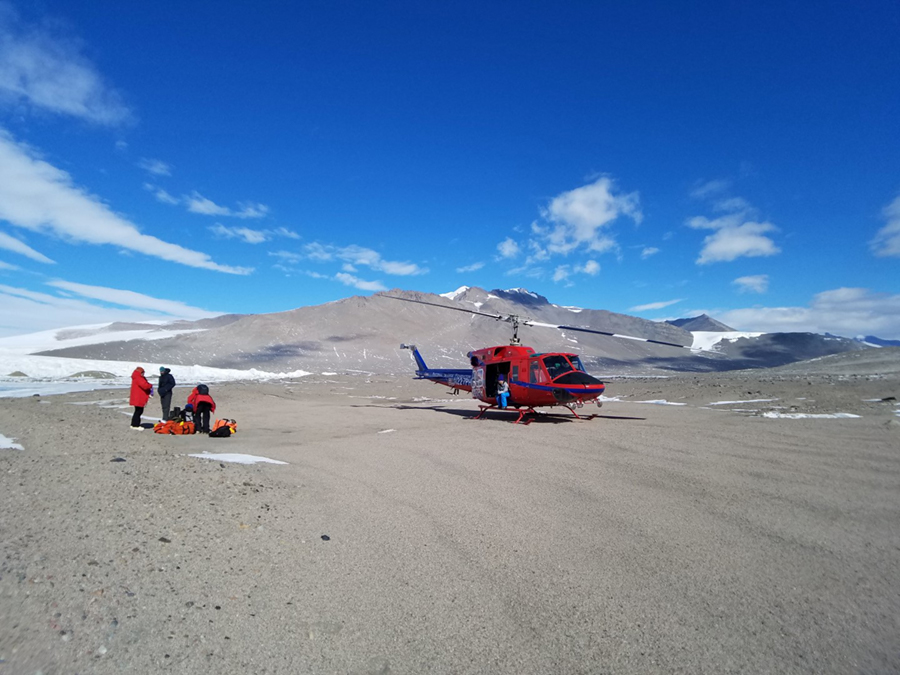
Photo Credit: David Goerlitz
The team steps off of their helicopter near Lake Brownsworth in the Wright Valley. They flew to numerous dried up lakebeds around the McMurdo Dry valleys to collect ancient DNA samples.
Johnson is also a part of NASA’s Curiosity Rover Science Team, which is searching for signs of habitability on the Martian surface, and the next mission to Mars will search for evidence of past life itself. The extreme cold and arid conditions in the McMurdo Dry Valleys make them one of the most similar environments on Earth to what exists on the Red Planet. “Antarctica is a great Mars analogue environment to try and do DNA sequencing,” said Scott Tighe, a geneticist at the University of Vermont. "We were able to prove that rapid DNA sequencing could be done in the field here.” Understanding how life can survive or persist in the Dry Valleys for possibly thousands of years could also change the way researchers hunt for life on Earth’s planetary neighbor. “Mars is a huge polar desert. If there’s life on Mars that’s similar to life in the Dry Valleys, our work may have implications for how we design life detection instruments,” Johnson said. 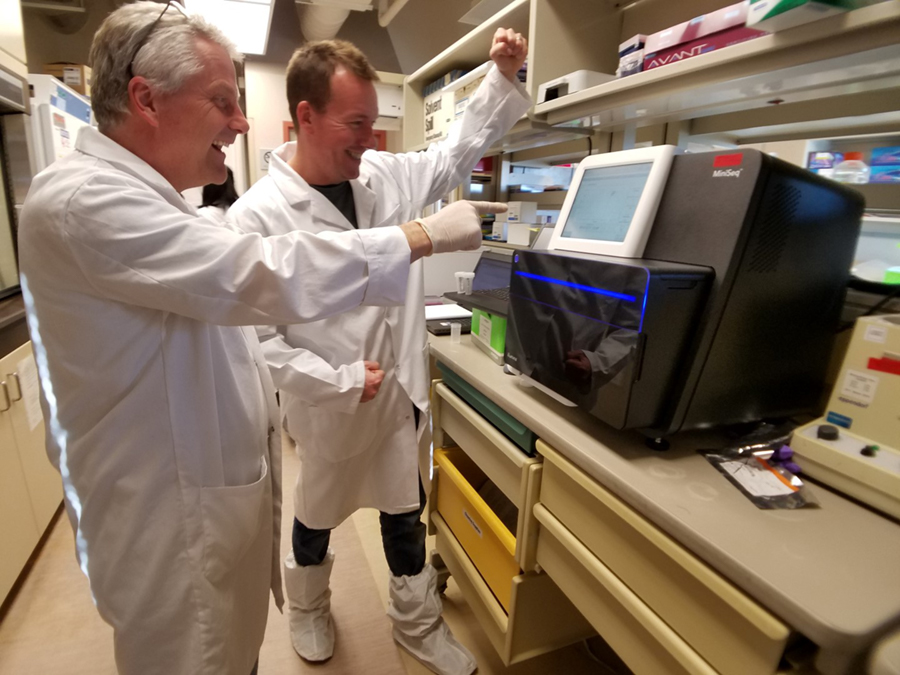
Photo Credit: Sarah Johnson
Scott Tighe (left) and David Goerlitz celebrate in the Crary lab after successfully sequencing DNA recovered in the Dry Valleys using an Illumina MiniSeq.
Perhaps even more tantalizingly, it raises the possibility of ancient, primitive spacefarers traversing the distance between the planets. “Mars and Earth exchanged an enormous amount of material during a time called the late heavy bombardment, just as life was getting started here on Earth. It raises the possibility that life on Earth and life on Mars could share a common ancestry,” Johnson said. Teams searching Antarctica and other parts of the globe occasionally find chunks of Mars that were knocked off of the planet by a meteorite impact, drifted across the solar system and ultimately fell to Earth. If life could be shown to be able to survive the thousands-of-years-long trip, it opens up the possibility that ancient microorganisms burrowed deep inside these rocks could have jumped from one world to the other. The team is continuing to process and sequence the ancient genomes from these ancient lakebeds. They’re currently in the process of identifying and tracing the lineages of the microbes they’ve recovered. NSF-funded research in this story: Sarah Johnson, Georgetown University, Award No. 1620976. |



For USAP Participants |
For The Public |
For Researchers and EducatorsContact UsU.S. National Science FoundationOffice of Polar Programs Geosciences Directorate 2415 Eisenhower Avenue, Suite W7100 Alexandria, VA 22314 Sign up for the NSF Office of Polar Programs newsletter and events. Feedback Form |


